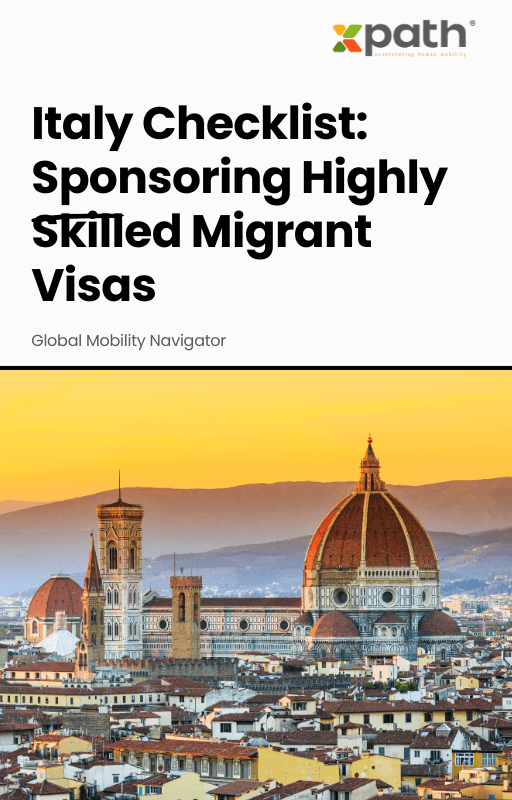Italy Checklist: Sponsoring Highly Skilled Migrant Visas
Grab a copy of a guide to international employee relocation
View E-bookCompanies increasingly rely on international assignments to drive growth, foster innovation, and build cross-cultural expertise. However, managing global mobility is no small feat. Missteps can lead to compliance risks, employee dissatisfaction, and costly failures. To navigate this complexity, organizations need a structured approach to global mobility management. Below, we break down the five core phases that form the backbone of any successful global mobility program.
Purpose: Lay the groundwork for a successful international assignment.
Before an employee even packs their bags, organizations must answer critical questions: Why is this assignment necessary? Who is the best candidate? What support will they need?
Key Components:
🔸Business Case Development: Align the assignment with strategic goals (e.g., market expansion, leadership development).
🔸Candidate Selection: Assess technical skills, cultural adaptability, and family readiness.
🔸Cost Projections: Budget for relocation, housing, taxes, and potential emergencies.
🔸Policy Alignment: Ensure assignment terms (compensation, benefits, duration) comply with company policies and host-country norms.
Best Practice: Use data-driven assessments to match candidates with roles and locations. Involve families early to address concerns about schooling, healthcare, or spousal careers.
Purpose: Facilitate a smooth transition to the host country.
This phase tackles the tangible aspects of moving employees and their families abroad. Poor execution here can lead to immediate stress and attrition.
Key Components:
🔸Immigration Support: Secure work visas, permits, and residency documentation.
🔸Moving Services: Coordinate shipping, temporary housing, and home-finding trips.
🔸Cultural Training: Prepare employees and families for cultural nuances (e.g., communication styles, local customs).
🔸Financial Support: Provide allowances for relocation costs, cost-of-living adjustments, and tax equalization.
Best Practice: Partner with relocation management companies (RMCs) to streamline logistics. Offer “destination services” to help families acclimate quickly.
Purpose: Mitigate risks related to immigration, tax, and employment laws.
Global mobility is a legal minefield. Non-compliance can result in fines, reputational damage, or even deportation of employees.
Key Components:
🔸Immigration Compliance: Track visa expiry dates and renewals.
🔸Tax Management: Navigate double taxation agreements, social security contributions, and payroll compliance.
🔸Employment Law: Ensure contracts adhere to host-country regulations (e.g., working hours, termination rules).
🔸Data Privacy: Comply with GDPR or local data protection laws when transferring employee information.
Best Practice: Work with in-country legal experts and invest in compliance software to automate tracking and reporting.
Purpose: Help employees thrive professionally and personally in their new environment.
A well-planned relocation means little if the employee struggles to adapt. Effective integration boosts productivity and retention.
Key Components:
🔸Role-Specific Training: Clarify job expectations and introduce local teams.
🔸Cultural Mentorship: Pair assignees with colleagues who understand the host culture.
🔸Community Building: Connect families with expat networks or local communities.
🔸Wellness Support: Provide access to mental health resources and medical care.
Best Practice: Schedule regular check-ins during the first 90 days to address challenges early.
Purpose: Ensure a successful return to the home country and retain acquired skills.
Repatriation is often overlooked, yet 25% of expats leave their company within a year of returning, citing poor reintegration (Brookfield Global Mobility Trends).
Key Components:
🔸Career Planning: Define post-assignment roles to leverage new skills.
🔸Reverse Culture Shock Training: Prepare employees for reintegration into their home office.
🔸Debriefing Sessions: Capture insights about the host market, customer needs, or operational improvements.
🔸Ongoing Support: Offer financial counseling or mentorship to ease the transition.
Best Practice: Treat repatriation as strategically as the initial assignment. Create alumni networks to maintain global connections.
Global mobility isn’t just about moving people—it’s about moving talent strategically. By mastering these five phases, organizations can:
🔸Reduce assignment costs and risks.
🔸Improve employee satisfaction and retention.
🔸Strengthen global leadership pipelines.
🔸Drive ROI from international operations.
Global mobility management is more than a logistical checklist—it’s a strategic imperative in a world where talent knows no borders. By embracing the five core phases—pre-assignment planning, relocation logistics, compliance coordination, onboarding integration, and repatriation—organizations transform short-term assignments into long-term value. These phases create a framework that not only safeguards against risks but also empowers employees to thrive in unfamiliar environments, fostering innovation and cross-cultural collaboration.
However, the true measure of success lies in recognizing that global mobility is a cyclical journey, not a one-time transaction. Employees return with invaluable skills and insights, but only if their experiences are thoughtfully managed from start to finish. Neglecting any phase—whether it’s inadequate pre-departure preparation or poorly planned repatriation—can erode trust, drain resources, and diminish ROI.
As remote work, geopolitical shifts, and evolving labor laws reshape the global landscape, companies must adopt agile, human-centric mobility programs. The organizations that succeed will be those prioritizing compliance without compromising empathy and strategy without sacrificing flexibility. By investing in these five phases, businesses don’t just move people—they move possibilities.
The question isn’t whether your organization can afford to prioritize global mobility management. It’s whether you can afford not to.
Ready to transform your mobility program? Explore xpath.global’s solutions.
Previous article

Italy Checklist: Sponsoring Highly Skilled Migrant Visas
Grab a copy of a guide to international employee relocation
View E-book